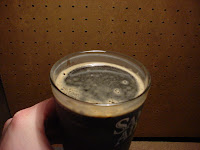So I have been kegging my beer for about a year now and I am still tweaking the process having not found "the ideal" method. I was just reading something on Homebrewmart.com that outlines the force carbonating process pretty well. For this entry I am going to give a brief overview of my method, and some changes I am going to try for this time around.
After the obvious, sanitize, transfer the beer to the keg with minimal aeration, and sealing the top, I start with the CO2. I usually hit the keg with 10-12psi to ensure a good seal and bleed off any O2 (using the valve at the top I let some out and have the CO2 replace the O2 from the transfer). After I have the keg sealed and all of the O2 out, I hit the keg with about 30-35psi until I can tell there is no more CO2 going into the keg.
If you have never done this process before, the way to tell things have equalized inside the keg and there is no more room for CO2 is actually pretty easy, there is no more noise. Once you hear that there is no more CO2 leaving the tank, the kegs got all the CO2 its going to handle.
Next I shake the keg vigorously, I go back and froth, roll it around on the floor, ext. I do this for a few minutes and then hit it with another shot of CO2. I repeat this process 4 or 5 times and let the keg rest for 1/2 hour or so and repeat the process.
After I feel that it's had enough (no logic about the how much on that one, just a shot in the dark), I release the excess pressure from the keg and hook it to the in (CO2 tank) and the out (keggerator) at 10-12psi and leave it over night.
So far the results have been good, not great. I have had a couple of kegs give me trouble and lead em to do the whole process over again. Other times it starts out totally heady and settles about 6-8 beers in. And still other times it's all over the charts.
I would love to get this down to a science so any recommendations are welcome. A quick note would be that the kegs are kept in my basement as a 60-65F temp.
In the end, its still beer and no matter how flat my love is, I still love it.












